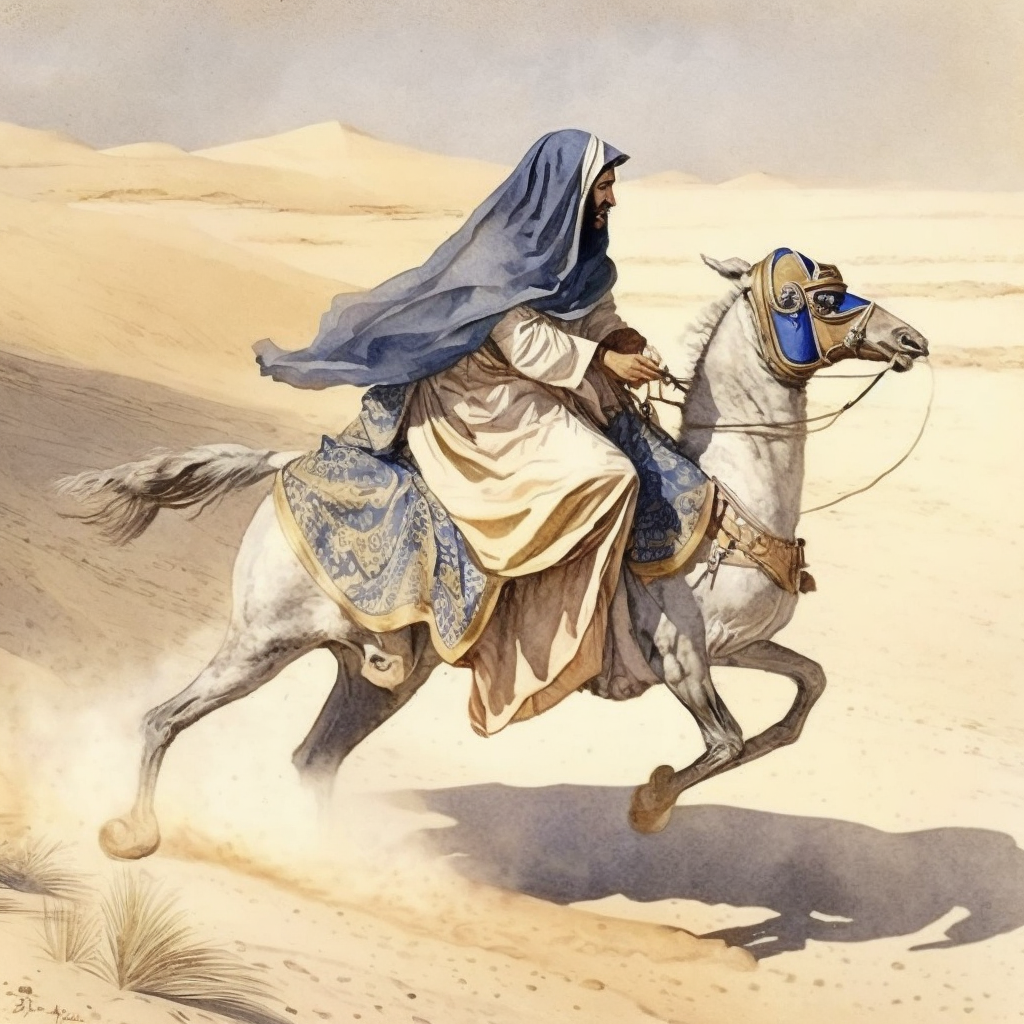In the heart of the Arabian Peninsula lies the vast and enigmatic Nafud Desert, a landscape of shifting sands and ancient mysteries. Among the pioneers who dared to unveil its secrets was William Gifford Palgrave, whose exploration laid the groundwork for a succession of intrepid travellers. Palgrave’s footsteps marked the beginning of a captivating journey into the heart of Central Arabia, inspiring others to follow suit. This text embarks on a compelling narrative, chronicling the tales of explorers who traversed the Nafud after Palgrave, capturing the essence of their encounters with Emir Muhammad ibn Rashid and the surprising facets of the seemingly inhospitable desert. As we delve into their expeditions, common themes and shared challenges will emerge, offering a glimpse into the allure and intricacies of this captivating region.
Exploration of Nafud Desert
William Gifford Palgrave’s bold expedition set the stage for subsequent explorers to unravel the mysteries concealed within the Nafud Desert. His successors, captivated by the allure of this central Arabian expanse, embarked on their own journeys of discovery. Before delving into the challenges and intricacies of the Nafud, we must acquaint ourselves with key figures who dared to venture into its inhospitable sands. Among them, Carlo Guarmani and Charles Huber stand as notable explorers, each contributing a unique perspective to the unfolding narrative. Their expeditions laid the foundation for a deeper understanding of the Nafud’s complexities and set the scene for the exploration tales that follow.
Charles Huber’s Expedition: Bridging the Desert Divide
In the late 19th century, French explorer Charles Huber embarked on a remarkable journey that spanned the expanse of the Nafud Desert. Originating from Damascus, his route led him to the heart of the Arabian Peninsula, where he successfully traversed the challenging terrain to reach the city of Hail. It was here that he encountered Emir Muhammad ibn Rashid, a central figure in North Arabia, whose influence and leadership left an indelible mark on the region.
Undeterred by the harsh conditions of the Nafud, Huber undertook a second crossing in October 1883, accompanied by the Strasburg Orientalist, Julius Euting. This collaborative effort not only reinforced Huber’s commitment to exploration but also added a scholarly dimension to the expedition. Euting, equipped with expertise in Semitic epigraphy, meticulously recorded ancient inscriptions, shedding light on the historical significance of the Nafud and its surroundings. Huber’s dual crossings, punctuated by encounters with Emir Muhammad ibn Rashid, provide a captivating chapter in the exploration of Central Arabia.
Carlo Guaramani
Carlo Guarmani (1828-1884), a notable Italian explorer following the footsteps of Palgrave, undertook a swift and efficient expedition through the challenging terrain of the Nafud Desert in 1864. On a mission to procure purebred Arabian horses for the French and Italian armies, Guarmani crossed the Nafud from Jubbe to Jauf, employing a strategy marked by speed and resourcefulness. Travelling primarily by night with a string of horses, he covered the daunting expanse in a manner that distinguished his journey. However, unlike his predecessor Palgrave, Guarmani did not provide a detailed account of the final stage of his Nejd journey within the Nafud. Guarmani’s expedition holds a significant place in the chronicles of Nafud exploration, contributing to the evolving tapestry of intrepid travels in Central Arabia.

Blunts’ Romantic Odyssey: Discovering Hospitality Amidst the Sands
In the tapestry of Arabian exploration, the Blunts—Wilfrid Scawen Blunt and his wife—wove a narrative coloured by romantic curiosity and an enduring fascination with Bedouin society. Their expedition in 1879 was fueled by a desire to unravel the cultural intricacies of the desert dwellers, transcending the typical motivations of scientific inquiry.
Venturing into the heart of the Nafud, the Blunts sought the company of the Emir of the Shammar. Their encounter with this influential figure, a central authority in North Arabia, revealed both the warmth of hospitality and the challenges posed by cultural differences. In their reflections, the Blunts offered a unique perspective, describing the Nafud not as an inhospitable wasteland but rather as a surprisingly welcoming home for Bedouins. Their journey, characterised by a blend of romance and cultural exploration, adds a distinct hue to the canvas of Arabian expeditions.
The Nafud’s Geography
To comprehend the allure and challenges of the Nafud Desert, we must navigate its geographical intricacies. The composition of its sands, the elevation that moulds its contours, and the tenacious vegetation that defies the arid environment collectively shape this central Arabian expanse.
The sand particles, while seemingly uniform, vary in weight and density. This divergence is particularly pronounced in the central region, where the sands exhibit a surprising resistance to the relentless winds that sweep across the desert. Notably, Charles Huber’s observations in June unveiled a striking greenness, challenging the conventional narrative of the Nafud as an unforgiving and desolate landscape. His account serves as a testament to the complex and resilient nature of the desert’s ecosystem.
As we delve into the geography of the Nafud, the interplay of its elements becomes a central theme, offering a nuanced understanding of a terrain that defies simplistic characterization.
European Sojourns in the Nafud: Eyewitness Accounts
The allure of the Nafud Desert drew only a handful of European travellers, contributing to the limited firsthand accounts of its exploration. Among these intrepid individuals, German Edward Nolde stands as a notable figure whose expedition in 1893 left an indelible mark on the annals of Arabian exploration.
Edward Nolde’s odyssey took him across the Nafud as he ventured from Damascus to visit the esteemed Emir Muhammad. A restless and somewhat fantastical soldier of fortune, Nolde’s narrative, while focused on his encounters with the Emir, delved deeply into the political changes that had swept through the kingdom. His account became a historical record, capturing the evolving dynamics between the Emir, various Bedouin stocks, and the overarching influence of Riyadh.
In the chronicles of European travellers in the Nafud, Nolde’s journey adds a layer of political intrigue, enriching our understanding of the region’s geopolitical landscape during a transformative period in its history.
Formation of Nafud’s Mystical Dunes
The origin of the Nafud’s mesmerising sands remains a geological enigma, with clues scattered across its vast expanse.
At the heart of the Nafud, the central region boasts red sands that bear the hallmarks of a bygone sandstone bed. This remnant, possibly the result of ages past, forms a unique tapestry within the broader landscape. The prevailing winds, often whispered to emanate from Jabal Shera, emerge as key orchestrators in the perpetual dance of shifting sands. These winds, both relentless and sculpting, bear the responsibility of moulding the dunes that define the Nafud’s character.
Notably, the presence of different sand types hints at varied origins. While the red sands dominate the central expanse, other regions bear the imprint of sands possibly originating from lava-covered landscapes. The interplay of these sands and the winds from Jabal Shera creates a symphony of textures and hues, turning the Nafud into a living canvas shaped by the forces of nature.
Falj Pits: Mysteries in the Nafud’s Sands
Amidst the expanse of the Nafud Desert lie enigmatic features known as falj pits—horseshoe-shaped depressions that pique the curiosity of explorers and scientists alike. Understanding the nature of these pits offers a glimpse into the subtle yet profound dynamics at play in the heart of the Arabian sands.
Falj pits, while a distinctive presence in the Nafud, are not exclusive to this desert; they are scattered across various Arabian sands. Their formation remains shrouded in mystery, with emerging theories suggesting a connection to wind action, particularly during electric storms of exceptional violence. This phenomenon, though rare, could potentially yield insights into the intricate processes shaping the desert’s topography.
A fascinating characteristic accompanying falj pits is the presence of white mounds or dunes on their windward side. This visual companion to the pits adds an extra layer of complexity to their origin and evolution. As we delve into the intricacies of falj pits, we embark on a journey to unravel the mysteries etched into the very fabric of the Nafud’s sands.

